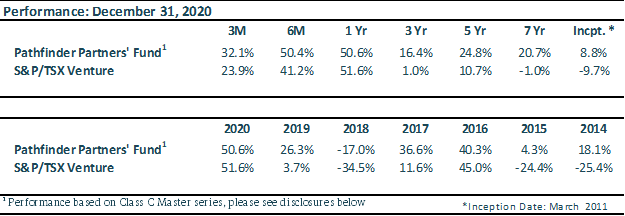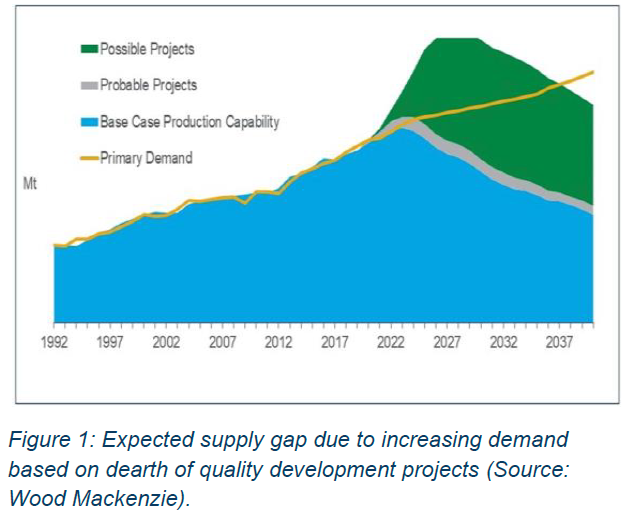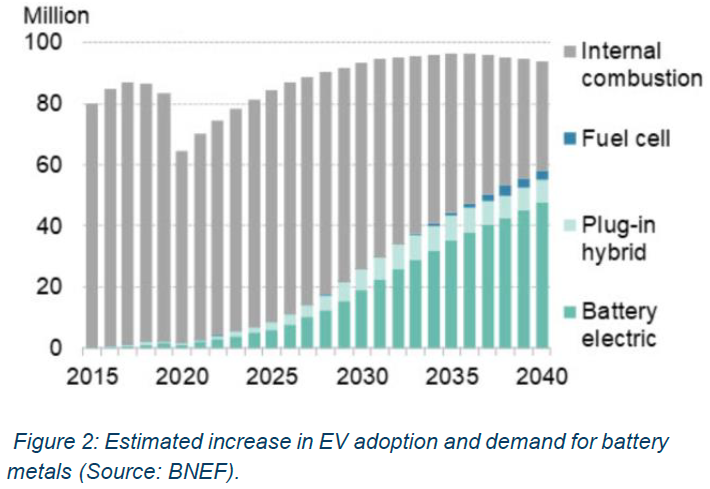Pathfinder Small Cap Quarterly Report
December 31, 2020
The Pathfinder Small Cap mandates invest in high-torque, early-stage companies that have the potential to generate superior returns.
Pathfinder Partners’ Fund
The Partners’ Fund had an annual net return of 50.6% in 2020. This compares to the TSX Venture Exchange which rose by 51.6%. Our annualized 7-year return is 20.7% compared to the TSX Venture Exchange’s return of -1.0% per year over the same period. The table below provides a performance summary:

During the year, our top contributors came from the clean-tech sector. Aurora Solar Technologies Inc (TSXv:ACU), Nano One Technologies Corp (TSXv:NNO), and Exro Technologies Inc (TSXv:EXRO) were among the top 4 contributors for the year. The other was Abaxx Technologies Inc (NEO:ABXX), which went public in December at several multiples above our purchase price. Abaxx is a fintech company attempting to disrupt the futures market and other exchanges through superior technology. The only significant detractor to our portfolio was Currency Exchange International (TSX:CXI), which was negatively impacted by reduced travel due to COVID-19. However, one of their major competitors recently went bankrupt and we believe in the opportunity, having added to our position towards year end.
This was an historic year by many metrics; COVID-19 ushered in changes ranging from the remote workplace revolution to how we socially interact with one another. The small-cap market was no less dramatic, with the Venture index plunging 35% from January to April as the impact of the global pandemic shook investors, only to rally 130% over the next 9 months and have its best year since 2009/2010. During the year, we were lucky (through no special foresight) to have had long-standing exposure to many of the best performing sectors and beneficiaries of the changing world in 2021. We also benefited from having the conviction to hold onto these positions despite high levels of volatility, fear, and uncertainty.
For example, the focus on remote healthcare and improving technology to better address the needs of the healthcare system saw our long-term holding VitalHub Corp (TSXv:VHI) perform well, up 63% for the year. It was not a smooth ride; we added significantly to our position in a financing at $1.80 per share immediately before the stock market sell-off in March, and the day our investment closed the stock hit a low of $1.20 per share (before bouncing back to $2.85 by the end of the year). We also had to endure a peak-trough decline of over 50% on our top gainer for the year, Aurora Solar Technologies (TSXv:ACU).
As we have written before, our investment process is based on fundamental research and the process of attempting to determine what a company is truly worth. If managed properly, an increase in volatility can provide us with higher returns by giving us more opportunities to buy stocks for less than they are worth and sell them for more. This process also gives us the confidence to hold certain stocks through tough times and add to them if it makes sense.
Last quarter, we wrote that despite a strong 6-month performance from the TSX Venture, we have not yet seen broad overvaluation in our investment universe, more so a frenzy in specific sub-sectors and themes. During the fourth quarter, this frenzy has continued and extended into ancillary sectors. Our buy list has shrunk dramatically and most of these ideas are no longer undervalued in our opinion. We hope to still be able to find ‘good’ deals, but ‘great’ deals are becoming scarce. Ignoring the fear of sounding like a broken record, we think our December 2017 Quarterly Report rings true again for this year as it did then. We are very pleased with the Fund’s performance, but caution that last years performance is unsustainable and not likely to be repeated. It is an investment axiom that high valuations reduce forward-looking return expectations and valuations are currently high. We provide the following quotes as food for thought:
“The long, long bull market since 2009 has finally matured into a fully-fledged epic bubble. Featuring extreme overvaluation, explosive price increases, frenzied issuance, and hysterically speculative investor behavior, I believe this event will be recorded as one of the great bubbles of financial history, right along with the South Sea bubble, 1929, and 2000.” – Jeremy Grantham
“Behold the most speculative and momentum-driven market on record.” – David Rosenberg
We agree with Jeremy Grantham and David Rosenberg that we are entering ‘bubble territory’ and turn to an examination of the tech bubble of the 90s for a potential roadmap. Jeremy Grantham is famous for having avoided several bubbles, but also called them early and missed out on returns before they popped. During 1999, at the zenith of one of the most spectacular bubbles of all time, the Nasdaq returned a whopping 82%. Bubble-callers on the sidelines missed out on an epic return. $100 invested in the Nasdaq grew to $182 over the next 12 months. The correct identification of a bubble does not mean stocks will immediately crash; they could easily continue to melt up. On the other hand, after this rise to $182, the Nasdaq fell to less than $40, a decline of almost 80%. We must be aware of the importance of protection of capital if we want to avoid a fatal portfolio decline such as this. Luckily, our process of attempting to value companies is tailor made for this situation. The appropriate course of action is to simply attempt to buy stocks that trade for less than they are worth and sell stocks that trade for more. If we are indeed in 1999, we expect this run up will provide us plenty of selling opportunities. Likewise, if we are on the precipice of a crash, the sells we have already made will hopefully protect capital while we search for undervalued buy opportunities.
To illustrate the difficulty of managing a portfolio during manic depressive market activity, we turn to a quote from the book “Where Are the Customers’ Yachts?” by Fred Schwed Jr.:
“When there is a stock-market boom, and everyone is scrambling for common stocks, take all your common stocks and sell them. Take the proceeds and buy conservative bonds. No doubt the stocks you sold will go higher. Pay no attention to this – just wait for the depression which will come sooner or later. When this depression – or panic – becomes a national catastrophe, sell out the bonds (perhaps at a loss) and buy back the stocks. No doubt the stocks will go lower still. Again pay no attention. Wait for the next boom. Continue to repeat this operation as long as you live, and you’ll have the pleasure of dying rich”
While the wisdom of the above quote is debatable (a lot of money has been lost by sitting on the sidelines), it provides insight into the mindset one should adopt and shows how emotionally difficult it can be even when making the correct decisions. In our opinion, we are about to embark on a wild year with extreme volatility, both positive and negative. We are keeping the above quote in mind and are ready for stocks we sell to go higher and new investments we buy to go lower. We hope to pay no attention to these shorter-term fluctuations as we manage the portfolio for maximum long-term performance. Thank you for your enduring trust and support!
Pathfinder Resource Fund
The Resource Fund had a net return of 69.9% in 2020. This compares to the benchmark which was up by 6.0%. Since inception (July 16, 2018), the Resource Fund has returned 24.4% annualized versus the benchmark of 0.2%. The benchmark consists of 75% of the daily return of the S&P/TSX Capped Materials Index and 25% of the daily return of the S&P/TSX Capped Energy Index.

After a strong start to the commodities sector in Q1 2020, we saw a major pullback in all sectors due to the pandemic by the end of the quarter. However, globally coordinated government stimulus contributed to higher commodity prices by year end. Gold gained 22% over the year ending just shy of US$1,900/oz after reaching an all-time high of US$2,035/oz in August. Similarly, copper prices rose 25% over the year underpinned by an increase in demand driven by China and renewed concerns around tightening supply. Overall, the story was a “risk-on” sentiment by investors which led to record highs in the equity markets driven by the trillions of dollars pumped into the economy through fiscal stimulus initiatives.
Due to this strong commodity market, we had fifteen companies add over 1.5% to gross returns and no detractors of more than 1.5%. Orca Gold Inc (TSX:ORG) benefited from the removal of Sudan from the U.S. State Sponsors of Terrorism list and added 7.0% to the portfolio for the year. Two of our other top performers were Pan Global Resources (TSXv:PGZ) and GR Silver Mining (TSXv:GRSL) contributing 6.7% and 5.1% to gross returns for the year respectively. Both of these companies are early in the mining life cycle (exploration) with additional upside remaining. We see a lot of similarities between both companies in terms of success through drilling and strategic acquisitions which open up the possibilities for additional discoveries. The only loss among our top 20 portfolio contributors was Gear Energy Ltd (TSXv:GXE) which decreased gross returns by 1.2%.
Pan Global continued to add value via the drill bit throughout the year, systematically expanding the footprint of their new discovery in 2020. They have been highly successful intersecting copper mineralization in every hole drilled to date demonstrating the continuity of mineralization. This highlights the effectiveness of the targeting methods used by PGZ which will now be directed towards the recently acquired Al Andalus property adjacent to their current La Romana discovery. While we remain enthusiastic about many of the untested targets at La Romana, Al Andalus also offers many targets with similar geophysical and geological characteristics as the current discovery. Drilling is expected to re-commence next week at La Romana and start at Al Andalus by mid-year.
GR Silver’s timely acquisition of the Plomosa’s property has catapulted this exploreco from a speculative exploration play to advanced exploration. The Plomosa’s project was acquired for ~$3M worth of equity despite having at least $8M previously spent on it through exploration work and infrastructure. Since the acquisition, GRSL has steadily advanced exploration through new discoveries and extending historic mineralized zones. The Company is now poised to deliver a new resource estimate by mid-year while continuing to execute on their district consolidation strategy. Concurrently, GRSL is working toward completing a definitive agreement in the near term to acquire the La Trinidad concessions. The additional ownership would allow the company to control the Rosario Mining district, a critical factor major mining companies consider during acquisition. We anticipate a catalyst rich year for GRSL and potential growth through additional strategic acquisitions.
For our outlook, we believe ongoing stimulus packages and fiscal policies will drive inflationary pressures which will in turn increase the demand for precious metals. The Fed continues to indicate support for the economy through maintaining low interest rates over the next few years. This policy accompanied by strong fundamentals for base metals underpins our thesis that commodities will perform well in the upcoming year. Supply constraints in base metals have been exasperated by a lack of new projects in the pipeline and demand is increasing from infrastructure spending and continued growth from China.
Estimates show that by 2030 copper demand is set to increase by ~25% and exceed supply drastically in the coming years (Figure 1).

On the battery metals front, a shift toward decarbonization and electrification will require high quality battery grade commodities. Currently, the market is equipped to meet demand; however, demand growth will inevitably result in price appreciation (Figure 2).

It is worth noting that we believe Figure 1 & 2 significantly underestimate copper demand and battery electric vehicle demand respectively. This underpins our investment thesis and is a key driver for commodity prices going forward.
Our most recent shift has been towards copper and battery metals in anticipation of an increasing global focus on green energy and sustainability. While we make these shifts with a long-term outlook in mind, we are constantly surprised at how quickly change can occur. During the fourth quarter, the price of copper rapidly rose 20%, from approximately $3.00/lb to $3.60 per pound, causing a correspondingly positive move in our copper equities during the quarter. Likewise, enthusiasm for battery metals sent our lithium holding Neo Lithium Inc (TSX:NLC) and our nickel holding Talon Metals Corp (TSX:TLO) up over 100% during the quarter. While we believe it is still early days in the battery metal trade and there is more to come, we are cognizant that these days market cycles seem to be shorter and play out more quickly. While we watch this trend play out, we are sharpening our pencils by looking at other sectors for the next opportunity.
National Instrument 31-103 requires registered firms to disclose information that a reasonable investor would expect to know, including any material conflicts with the firm or its representatives. Doug Johnson and/or Pathfinder Asset Management Limited are an insider of companies periodically mentioned in this report. Please visit www.paml.ca for disclosures.
* All returns are time weighted and net of investment management fees. Returns from the Pathfinder Partners’ Fund are presented based on the Class C Master series except prior to its inception in July 2011 when the Class A Master series was used. Inception returns include the 10 months from inception in March 2011. Returns greater than one year are annualized. Returns from the Pathfinder Resource Fund are presented based on the Class C Master series since its inception in July 16, 2018. The S&P/TSX Venture Composite Index (C$), the S&P/TSX Venture Composite Index, the S&P/TSX Capped Materials Index and the S&P/TSX Capped Energy Index provide general information and should not be interpreted as a benchmark for your own portfolio return. Further details of the Partners’ Fund are available on request.
Pathfinder Asset Management Limited (PAML) and its affiliates may collectively beneficially own in excess of 10% of one or more classes of the issued and outstanding equity securities mentioned in this newsletter. This publication is intended only to convey information. It is not to be construed as an investment guide or as an offer or solicitation of an offer to buy or sell any of the securities mentioned in it. The author is an employee of PAML, but the data selection, analysis and views expressed herein are solely those of the author and not those of PAML. The author has taken all usual and reasonable precautions to determine that the information contained in this publication has been obtained from sources believed to be reliable and that the procedures used to summarize and analyze such information are based on approved practices and principles in the investment industry. However, the market forces underlying investment value are subject to sudden and dramatic changes and data availability varies from one moment to the next. Consequently, neither the author nor PAML can make any warranty as to the accuracy or completeness of information, analysis or views contained in this publication or their usefulness or suitability in any particular circumstance. You should not undertake any investment or portfolio assessment or other transaction on the basis of this publication, but should first consult your portfolio manager, who can assess all relevant particulars of any proposed investment or transaction. PAML and the author accept no liability of any kind whatsoever or any damages or losses incurred by you as a result of reliance upon or use of this publication.